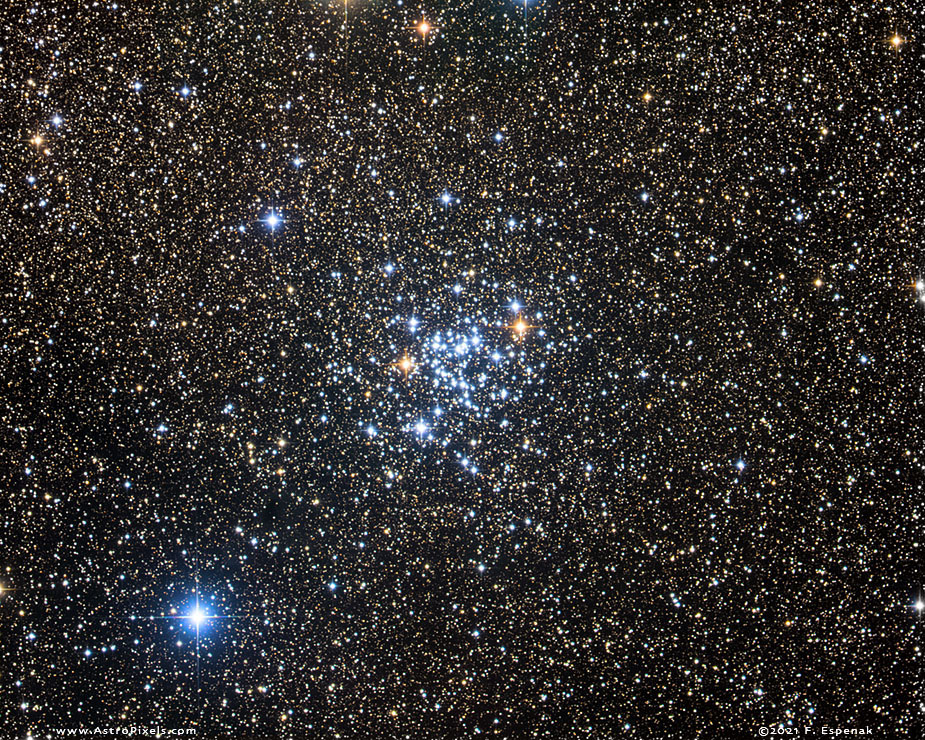NGC 3766 (Caldwell 97)
NGC 3766 (also known as Caldwell 97) is an open cluster in the constellation Centaurus. It has an apparent visual magnitude of 5.3 and its angular diameter is 12 arc-minutes.
NGC 3766 lies at an estimated distance of 5500 light years. It is located in the vast star-forming region known as the Carina molecular cloud, and was discovered by Nicolas Louis de Lacaille during his astrometric survey in 1751–1752.
There are 137 listed stars, but many are likely non-members, with only 36 having accurate photometric data. Total apparent magnitude of 5.3 and integrated spectral type of B1.7. NGC 3766 is relatively young that is estimated as log (7.160) or 14.4 million years, and approaching us at 14.8 km/s. This cluster contains eleven Be stars, two red supergiants and four Ap stars.
36 examples of an unusual type of variable star were discovered in the cluster. These fast-rotating pulsating B-type stars vary by only a few hundredths of a magnitude with periods less than half a day. They are main sequence stars, hotter than δ Scuti variables and cooler than slowly pulsating B stars.
The Equinox 2000 coordinates are 11h 36.1m, -61° 37´ which makes NGC 3766 a Southern Hemisphere object that is best seen during the spring. The Caldwell Spring Star Chart shows the position of all Caldwell objects visible during that season. Visit the Caldwell Catalog Photo Gallery to see more objects from this catalog.
Technical Details
- Object: NGC 3766
- Other Names: Caldwell 97
- Object Type: open cluster
- Object Data: Apparent Magnitude = 5,3, Angular Size = 12 arc-minutes
- Object Position (Equinox 2000): 11h 36.1m, -61° 37´, Constellation = Centaurus
- Date: 2021 Mar 11-12 (2 nights)
- Location: Chile Remote Observatory, Observatorio El Sauce, Chile
- Partnership: Operated in partnership with David Churchill
- Telescope: Planewave CDK-17 (with Focal Reducer: f/4.5; FL = 1945mm)
- Camera: QHY 16200A with Integral 7-position Filter Wheel
- Mount: Astro-Physics 1600GTO
- Sub-Exposures: Astrodon Filters
- Luminance: 24 x 5 min = 120 min
- Red: 24 x 5 min = 120 min
- Green: 24 x 5 min = 120 min
- Blue: 24 x 5 min = 120 min - Total Exposure: 8h 00m
- File Name: NGC3766-CDK21-C01w.jpg
- Field of View: 38.9' x 58.3' at 0.64 arc-sec/pixel
- Original Image Size: 3630 x 4540 pixels (16.5 MP); 12.1" x 15.1" @ 300 dpi
- Data Acquisition: David Churchill
- Image Processing: Fred Espenak
- Maxim DL: Image Calibration, Stacking, Digital Development Processing
- Adobe Camera Raw: Noise Reduction
- Photoshop CC: Curves, Levels, Unsharp Mask - Copyright: Fred Espenak
